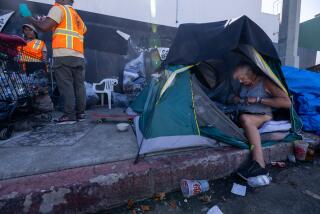U.S. Urged to Boost Outlays for Housing : $6.5 Billion More a Year Needed, Study Concludes
- Share via
WASHINGTON — The government will have to spend $6.5 billion more a year on housing over the next 15 years if every American is to have a decent, affordable place to live, an industry-backed study said Wednesday.
The study, financed by the National Assn. of Realtors, estimated that the nation will need to spend $41 billion to help build or renovate 36 million housing units over the period because many Americans now live without adequate plumbing, sewage disposal, electricity or in overcrowded conditions.
In addition, $56 billion over current levels will be needed to subsidize families that would otherwise have to pay more than the recommended 30% of their income for housing, according to the study performed by the Urban Institute, a research organization.
“We are reminded daily of the homeless on our streets and shelters. Less visible, but no better off, are those who live in inadequate housing or who pay the majority of their incomes just to stay off these streets,” said Nestor Weigand, president of the realtors association, who presented the study at a news conference.
Fewer Can Afford Homes
“If we don’t take some affirmative action,” the “primary American dream of home ownership” will not be realized for growing percentages of people, the real estate executive said.
With the widening gap between income and housing costs, home ownership for people between the ages of 25 and 34 has dropped 20% so far in the 1980s, he said.
In addition to government help to build and upgrade housing, Weigand recommended restoring tax incentives for investment in low- and moderate-income housing, more local government action to encourage building and a law to allow younger people to use tax-free retirement funds for a down payment on a home.
The study, “America’s Housing Needs to the 21st Century,” said 7.7 million households are living in substandard units and 3.2 million others are in overcrowded conditions.
It said more than 6% of housing units in urban areas and 17% of units in rural areas don’t meet minimum standards set by the Department of Housing and Urban Development.
HUD classifies a dwelling as substandard if it does not have electricity, lacks adequate plumbing or lacks sewage disposal.
Working on Legislation
The study did not address the likelihood of getting additional funds through Congress at a time of budget constraints imposed by the high federal deficits.
John Tuccillo, the realtors association chief economist, said the group is working with members of Congress on comprehensive housing legislation that he expects to pass next year. The Reagan Administration has generally opposed any new housing initiatives and scaled back many of the programs in existence when it came into office in 1981.
The study is the latest of several recent reports looking into the country’s housing needs. In March, the National Housing Task Force issued a report recommending a 12-year program with a goal of providing livable housing for all Americans.
More to Read
Sign up for Essential California
The most important California stories and recommendations in your inbox every morning.
You may occasionally receive promotional content from the Los Angeles Times.










